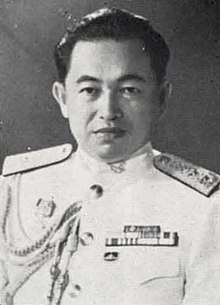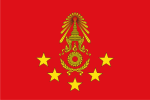Kris Sivara
Kris Sivara (Thai: กฤษณ์ สีวะรา, RTGS: Krit Siwara, alternatively transcribed as Srivara) (27 March 1914 – 28 April 1976) was a military officer of the Royal Thai Army, a member of the Thai Cabinet, and deputy commander-in-chief of the Royal Thai Army during the violent crackdown on democracy protesters on 14 October 1973. He was later promoted to army commander.
Kris Sivara กฤษณ์ สีวะรา | |
|---|---|
 | |
| Minister of Defence | |
| In office 21 April 1976 – 28 April 1976 | |
| Prime Minister | Seni Pramoj |
| Preceded by | Pramarn Adireksarn |
| Succeeded by | Tawich Seneewong |
| Supreme Commander of the Armed Forces | |
| In office 1 October 1974 – 30 September 1975 | |
| Preceded by | Dawee Chullasapya |
| Succeeded by | Sangad Chaloryu |
| Commander in Chief of the Royal Thai Army | |
| In office 1 October 1973 – 30 September 1975 | |
| Preceded by | Praphas Charusathien |
| Succeeded by | Boonchai Bamroongpong |
| Personal details | |
| Born | March 24, 1914 Bangkok, Siam |
| Died | April 28, 1976 (aged 62) Bangkok, Thailand |
| Spouse(s) | Surai Sivara |
| Alma mater | Chulachomklao Royal Military Academy |
| Military service | |
| Allegiance | |
| Branch/service | |
| Rank | |
| Commands | Commander-in-Chief Supreme Commander |
| Battles/wars | |
Career
During the Burma Campaign in World War II, Kris served as a company commander in a Phayap Army battalion under the command of Major Sarit Thanarat.
Kris was appointed Deputy Minister of Education by Field Marshal Thanom Kittikachorn in his 1969 government. On 23 November 1970, he was switched to Deputy Minister of Defence (Thanom was both premier and minister of defence). The government fell on 17 November 1971 after Thanom led a coup that overthrew his own government and abrogated the 1968 constitution. Thanom appointed Kris Minister of Industry in his subsequent junta.
Kris played a pivotal role in the 14 October democracy movement of 1973. Kris served as Deputy Army Commander in the face of massive public demonstrations against the "three tyrants": Colonel Narong Kittikachorn, Army Commander General Praphas Charusathien, and Prime Minister and Supreme Commander Thanom Kittikachorn. On the evening of 14 October, the police and army began shooting at demonstrators, killing at least 70. Narong shot into the crowds from a helicopter.[1] Thanom and Praphas resigned from their political roles, but continued to lead the military. They ordered more troops to confront the remaining demonstrators, but were blocked by Kris. Thanom and Narong then resigned from their military positions. The king then appointed Sanya Dharmasakti as premier. Kris was named defense minister in 1976, but died a week later in April 1976. His death has been called "...sudden and strange..."[2]:4
Kris's role in the events was countered by Narong in a 2003 book. Narong blamed Kris, among others, for the violence. The book was strongly criticised by former student leaders.[1]
The army's Kris Sivara Camp in Sakon Nakhon Province is named after him.
Honour
Foreign honour

References
- Can ไทเมือง (2010-08-10). "ย้อนรอย 30 ปี 14 ตุลา ...นายเทพมนตรี ลิมปพยอม ผู้แก้ตัวให้ 3 ทรราช". Oknation (in Thai). Retrieved 2017-10-15.
- Chambers, Paul (2016-08-15). "Under the Boot: Military-Civil Relations in Thailand since the 2014 Coup" (PDF). City University of Hong Kong. Southeast Asia Research Centre (SEARC) Working Paper Series No. 187. Retrieved 17 November 2017.
- "Semakan Penerima Darjah Kebesaran, Bintang dan Pingat Persekutuan".
Further reading
- Paul M. Handley, "The King Never Smiles" Yale University Press: 2006, ISBN 0-300-10682-3
External links
- The Nation, "Uprising: Narong 'is distorting history'", 31 Aug 2003
